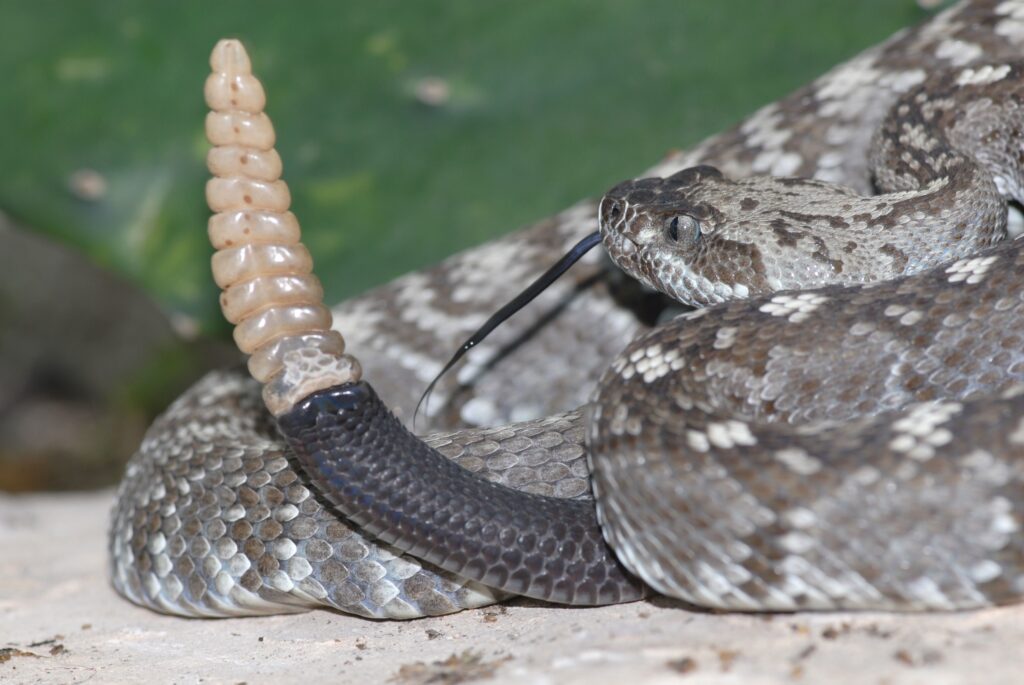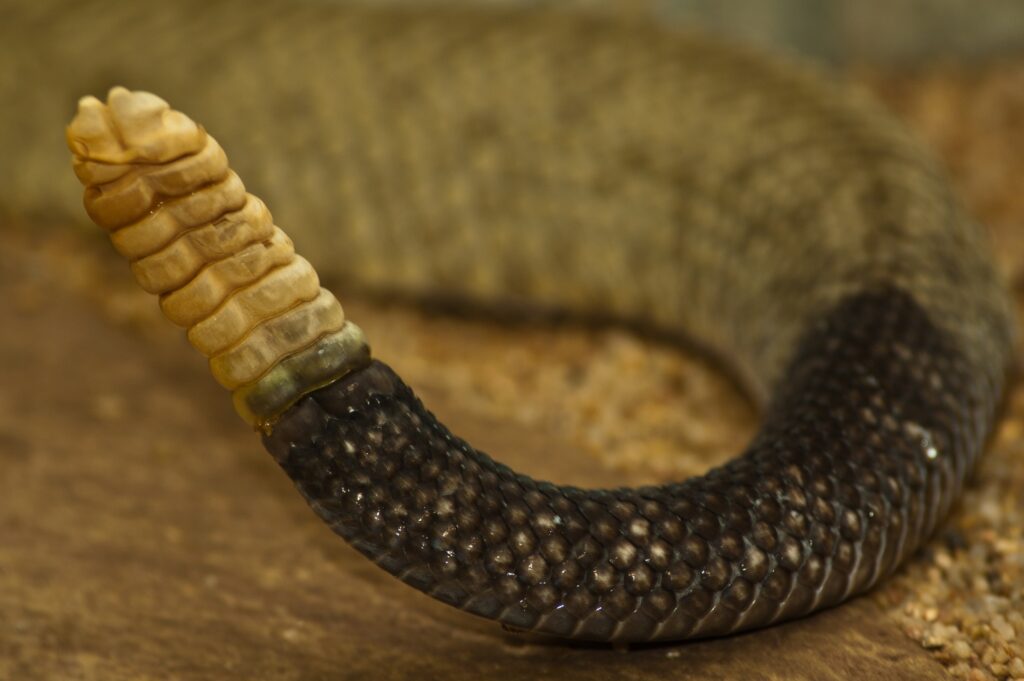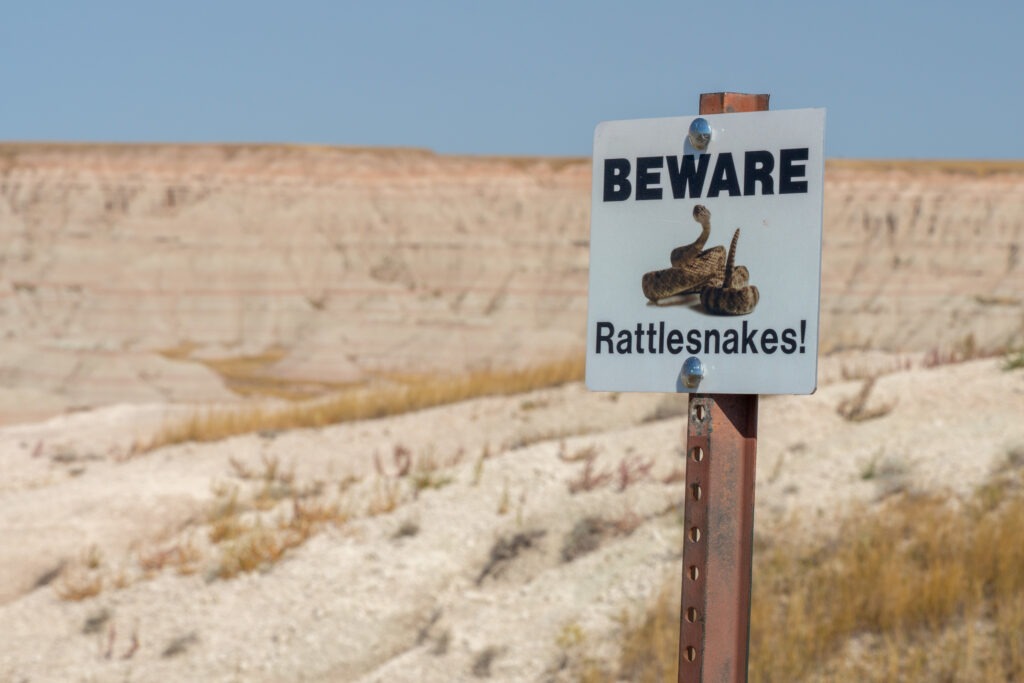
Rattlesnakes get their name from the distinctive rattles on the ends of their tails. These rattles vary in length, color, and a new rattle segment gets added with each new layer of skin that the rattlesnake sheds. But how old is a rattlesnake with 3 rattles?
Here’s what I’ve observed:
As a general rule, a rattlesnake with 3 segments on its rattle is approximately 1 year old. Rattlesnakes grow a new rattle segment every time they shed their skin. But, they don’t shed at a regular rate, so you cannot completely tell how old a rattlesnake is from its rattle.
Also, sometimes rattles break off.
Even though it is very difficult to determine the age of a rattlesnake based on the length of its rattle, there is a lot we can learn when we understand how rattlesnakes’ rattles work.
I have put some information together to help you better understand what makes these things rattle and how they grow. Here’s everything that there is to know about a rattlesnake’s rattle.
Rattlesnake Skin
Snakes, especially rattlesnakes, have evolved a skin that not only protects them but also helps to camouflage them.
Their skin is made up of scales that are flexible and strong. Unlike humans, who shed their skin little by little as new skin is grown, snakes have an underlying layer of skin called the corneal layer, which does not grow. That is why snakes must shed their skin as they grow larger.
To shed their skin, they must peel it back and cast it off so the new layer of skin can replace it.
Rattlesnake Rattles

When a rattlesnake sheds their outer skin, the new layer always contains another rattle for the snake’s tail.
While some people think that these rattles contain pebbles or other hard objects that shake against the rattle, these rattles are actually just a different form of scale- one that is hollow.
These hollow scales are loosely connected in such a way that when the rattlesnake shakes its tail rapidly, the tail scales shake and knock against one another to make the recognizable rattling sound.
These unique hollow scales are evidence that the rattlesnake is highly evolved.
In fact, rattlesnakes are considered to be the most evolutionarily advanced of all snakes. Each species of rattlesnake is highly specialized to the environment where it lives. From the diamondback to the pygmy, the different markings on a rattlesnake allow it to blend in wonderfully with the environment where it hunts.
Rattlesnakes can be found in many different regions and areas around the country.
They live in all sorts of habitats and have adapted to fill the unique demands of each place. Depending on where you are, the rattlesnakes you will see will have very different appearances and strategies that allow them to fit into their environment.
Can I Determine the Age of a Rattlesnake?
Because rattlesnakes grow a new rattle with each and every shedding of their skin, some people think that you can tell the age of a rattlesnake simply by counting how many rattles it has on its tail.
However, rattlesnakes do not shed their skin at a regular pace.
Young rattlesnakes that are still growing shed their skin a lot more often, shedding as many as four times every year. Older rattlesnakes shed only 2 or three times a year.
Another factor involved in how often a rattlesnake shed is how much it eats. Rattlesnakes that eat regularly will grow larger and will need to shed more times than other rattlesnakes to fit their growing body.
Something else that affects a rattlesnake’s growth and skin shedding is the climate. In warmer, drier climates, rattlesnakes will shed more often because they are more active and their skin wears out more. Seasons also come into account.
Most rattlesnakes (being cold-blooded) get relatively inactive during the winter.
During these months, rattlesnakes are not growing at all and thus they do not shed their skin. Although most rattlesnakes do go into a period of inactivity in winter called “brumation, not all of them live in climates where this is needed.
There are some species of rattlesnakes that remain active during the winter months, although they spend most of their time moving around trying to regulate body temperature.
Furthermore, rattlesnakes can be prone to losing rattles from their tail.
The hollow scales that make up their rattles are vulnerable and can break off fairly easily. Consider your own hair and fingernails; it doesn’t take much force to break them and the same thing is true for rattlesnakes.
A rattle with only a few segments will do the job just as well as a rattle with many segments, so rattlesnakes are not harmed by losing part of their rattle.
Because of the many, many variables involved in how long a rattlesnake’s rattle is, it is impossible to accurately guess the age of a rattlesnake by its rattle.
In fact, there is no accurate way of measuring the age of a rattlesnake at all. The only indication that a rattle could have towards a rattlesnake’s age is if the snake and the rattle are very small, with the tail containing only 2 or 3 segments.
In this case, you can say with some assurance that the rattlesnake is young, probably within its first year of life.
The Purpose of the Rattlesnake Rattle
Rattlesnakes use their rattles as a defense mechanism.
The rattling sound that they make is distinctive in the wild and easily recognizable. Rattlesnakes rattle because although they are very venomous and usually well disguised, they lack other forms of self-defense. Rattlesnakes are preyed upon by many species of birds and small mammals, but the snake uses the rattle to make their predators think twice about hunting rattlesnakes.
The rattle is also useful in warning larger mammals (like deer) of the rattlesnake’s presence.
Think about the reaction your mind and body have to your alarm that wakes you up in the morning. In that same way, the rattlesnakes rattle triggers in all of us the need to be careful and proceed with caution.
Unfortunately, the rattle often fails to do its job.
Many birds and mammals are resistant to the rattlesnake’s venom, which means that in many cases, the rattling of the snake’s tail has done nothing but give away the rattlesnake’s position.
Many rattlesnakes rattle to warn away deer or bison only to be trampled by their hooves. Rattlesnakes also expose themselves to humans, which are likely to exterminate the rattlesnake instead of leaving it alone.
Because of these drawbacks to the rattle, many rattlesnakes have stopped using their rattle entirely.
In some states, rattlesnakes have been observed to have atrophied tail muscles. These tail muscles (which on typical rattlesnakes are capable of shaking their tail as many as 100 times per second) seem to have been weakened from disuse.
It may be that rattlesnakes are evolving to not rattle anymore because of the way that humans react to the buzzing sound.
Instead of using a tool that is likely to get them shot and killed by humans, snakes may instead be relying more on their stealth and camouflage
The rattlesnake rattle sound
As mentioned before, the reason that we hear the rattling sound is very different than you might think.
The rattle of a rattlesnake is not like a maraca, relying on loose objects like a pebble to bounce around and produce sound. Instead, it is made up of the loose, hollow segments that you can see, which bounce around and strike each other when the tail is vibrated. It is these segments hitting each other that produce the distinctive sound of the rattle. (source)
How does the rattlesnake rattle sound change over time?
This is an important question to understand because not all rattlesnakes have the same capacity to rattle. It’s likely that a young rattlesnake will not be able to rattle at all. (source)
The scales and rattle of the rattlesnake are made of keratin, which is actually the same thing our hair and fingernails are made of. This material is what forms each “button” AKA the layers on the rattlesnake rattle.
Every rattlesnake is born with one of these buttons, however, having only one will not allow them to produce the rattling sound they are known for. It is not until the second and third buttons form that the snake can rattle. New buttons are formed as the snake sheds its skin which often happens within a few days for a baby rattlesnake.
Also because a baby rattlesnake’s rattle is so small, the sound it makes can be quite faint and high pitched. You might not even notice it if you are talking loudly, or you might mistake it for some kind of insect sound.
As snakes continue to shed their skin, they add buttons to their rattle, which adds to their ability to make noise. Unfortunately for rattlesnakes, these buttons are very fragile and it is common for them to break off. It is not very common that you will see a rattlesnake with more than 10 buttons. (source)
Weaknesses of the Rattlesnake rattle
Unfortunately for rattlesnakes, there are a lot of weaknesses to this defense mechanism that rattlesnakes use. Despite being portrayed on TV programs and movies as this big scary animal, rattlesnakes really are not that mean.
The reason that rattlesnakes rattle is not to show us how big and mean they are, but it is actually a reaction that happens when they are scared.
As mentioned before, rattlesnakes really don’t have many other defensive tactics other than this rattle. Generally, this rattle works in scaring off the unsuspecting animal, but a lot of times it triggers a frenzied response from animals and the rattlesnake puts itself in danger.
What do you do if You Hear a Rattlesnake Rattle?
Just like rattlesnakes, you don’t want to be harmed, and if you hear that rattling sound it can be very scary. If you hear the rattling sound, there is no need to freak out and start running.
The truth is that although it is scary to get bit by a rattlesnake, their venom is not as dangerous to a full-grown adult as it is to the smaller animals they hunt. According to the United States Center for Disease Control and Prevention, there are about 7 or 8 thousand venomous snake bites per year.
Of those that are bitten, only 5 people die on average per year. (source) This means that less than one percent of those bitten by venomous snakes die.
Please understand that I am not saying you should go and find rattlesnakes to play with, but I am saying that freaking out is not the best response when you hear that rattle sound.

Like I said before, the rattling is a response that comes from a snake who is scared and wants to warn predators to get away. A rattlesnake does not know that you are not a predator and they just want you to go away.
Rattlesnakes typically blend into their environment and when you hear the rattling, it can be hard to know exactly where the rattlesnake is.
As soon as you hear the snake it’s best to stop and survey the scene. Nothing would be worse than freaking out and running right into the snake. Once you determine where the sound is coming from, slowly back away in the opposite direction.
What if I am Bitten by a Rattlesnake?
If you don’t hear the rattle in time and you have been bitten by a rattlesnake, it’s ok.
Take a deep breath and try to stay calm. The most important thing for you to do is to go get some medical attention as soon as you can. Just because the symptoms are not setting in does not mean that the bite is not dangerous.
You may not always be in a situation where medical attention is readily available.
If this is the case, here are a few things you can do on your way to a hospital:
- Do not raise the bitten area above the level of your heart.
- Stay as still as possible.
- Remove tight clothing or jewelry to minimize swelling.
- Place a clean bandage on the wound.
These are just some simple things to do that may help you until you can get medical attention. Although you may have seen it in a movie, it is not a good idea to cut yourself in an attempt to suck out the venom from a snake bite.
Of course, I have to point out that I am not a doctor and I do not provide medical advice. I have years of experience in being around rattlesnakes, handling rattlesnakes, and removing them. But I have not been bitten, although I know people who have. You should not take my article as medical advice and if you need medical advice, and especially if you or someone you know has been bitten by a snake, you should immediately call 911 and seek out qualified medical assistance as quickly as possible.
